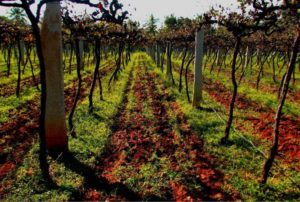W(h)ining about Climate Change: Sula Wines

Understanding the impact of climate change on India’s leading wine producer
“This year the effect of climate change and global warming is highly apparent, with our harvest starting fully two weeks earlier than ever before” – Rajeev Samant, CEO, Sula Wines [1]
In January 2016, Sula Wines, India’s leading wine producer, issued a press release to flag the growing impact of unseasonal rainfall on its grape harvest. This declaration has pushed to the forefront the question of whether supply-side, climate-change driven constraints may potentially curb the growing momentum of India’s burgeoning wine industry. Erratic monsoons and deteriorating soil quality portend the inevitable stagnation of an industry that has been touted one of the leading drivers of rural employment in two of India’s most populous states.
India has not traditionally been a market for wine. In recent years, accelerating GDP growth, higher disposable income and a cultural shift towards the West have driven 15%+ year-on-year growth [2] for the Indian domestic wine industry. In 2015, annual wine production hit 27 million liters [2], bolstered by government incentives such as tax breaks and special “agri-zones”. On the back of millennials and their affinity for wine culture, the market is expected to continue double digit growth in the coming years. [2]
Wine production in India is concentrated in the central-west/south-west of the country with Nashik district accounting for ~80% of output. [3] The sub-tropical climate leads to an unusual harvest cycle with grapes being harvested in month of December, ~3 months after the monsoon season. Sula wines, market leader with 24% market share [2], was one of the pioneers in this region.
Sula: Has growth peaked?
Established in 1997 by Rajeev Samant[4], Sula was the first wine producer to successfully scale out of the niche-y super premium wine market. It marketed itself as a truly domestic, Indian wine and employed innovative marketing tools such as tastings, wine education events and “Sulafest”. Through these efforts, Sula managed to put wine on the map for a whole new segment of India’s population and effectively created a market for itself.
 Sula has 2 wineries with a combined capacity of 8 million litres[4]. It has 1800 acres[4] under plantation of which ~20% is owned and the remaining is contract grown[5]. The company has done a lot for the struggling farmers in the region, both in terms of providing employment as well as initiating sustainability measures such as rain-water harvesting and vermi-compost[5]. Despite these efforts, Sula has not been able to escape the impact of growing irregularity in rainfall.
Sula has 2 wineries with a combined capacity of 8 million litres[4]. It has 1800 acres[4] under plantation of which ~20% is owned and the remaining is contract grown[5]. The company has done a lot for the struggling farmers in the region, both in terms of providing employment as well as initiating sustainability measures such as rain-water harvesting and vermi-compost[5]. Despite these efforts, Sula has not been able to escape the impact of growing irregularity in rainfall.
The wine-growing region of India is impacted by the South-West monsoon winds which blow from June-September. However recent years have seen droughts in the monsoon months followed by unseasonal rainfall later in the year. A recent study [6] using PRECIS (Providing Regional Climates for Impact Studies), a state-of-the-art climate modelling system, indicated that under scenarios of increasing greenhouse gas concentrations and sulphate aerosols, temperature and rainfall were expected to increase. West Central India (where Nashik district is located) showed maximum expected increase in rainfall.
While drought depletes the quality of the soil, unseasonal rainfall causes grapes to fall off vines prematurely, thus not allowing them to mature and develop a robust flavor. In recent years, Sula has struggled to get the yield it requires to scale its high-quality wines. Not only does this make production planning difficult, but in the absence of adequate quality grapes, Sula must resort to producing more of the lower-quality, less-premium wines while taking a hit on margin.
Sula’s attempts to mitigate these problems have been two-fold. First, there is a strong emphasis on sustainability measures (as mentioned earlier) to counteract the impact of drought and deteriorating growing conditions. Second, they are considering relocating their contract growing to a neighboring state which has been comparatively less impacted by climate-change driven rain fluctuations. This however, adds a whole new dimension of complexity to their supply chain since they will now have to transport the input grapes as opposed to being effectively co-located. Product and quality considerations also arise since the soil in the new location is not ideal.
All these issues beg the question as to whether Sula will be able to sustainably cater to the potential demand that it created for itself. While the answer to this is unclear, an honest recognition of the issues is a step in the right direction.
Endnotes
[2] Euro Monitor: Wine in India; Category Briefing
[4] http://sulawines.com/aboutmore.aspx?catid=1
[5] Company Expert interviews
[6] ‘High-resolution climate change scenarios for India for the 21st century’ – K. Rupa Kumar*, A. K. Sahai, K. Krishna Kumar, S. K. Patwardhan, P. K. Mishra, J. V. Revadekar, K. Kamala and G. B. Pant. Indian Institute of Tropical Meteorology




Tarunika – this was a fascinating piece. I had not realized how large the Indian wine industry was. I know very little about the wine production process, but can certainly appreciate how difficult it is for a wine producer to produce a consistent, high-quality wine over time -there is a very fine line between a masterpiece wine vs. an underwhelming wine. Even the smallest alteration in temperature, soil quality, precipitation level and moisture level can drastically change the taste and body. Climate change and subsequent extreme weather variations must be one of the biggest challenges for the wine industry to tackle.
It sounds like Sula is thinking through the right issues. Beyond Sula’s current sustainability initiatives like rain-water harvesting and vermi-compost, I thought they may have the opportunity to engage with (and learn from) other wine producers around the world to study how they are coping with this issue. Journal of Wine Economics could be a good resource for Sula. For example, this journal piece has some examples from other countries as well: http://www.wine-economics.org/aawe/wp-content/uploads/2016/06/Vol11-Issue01-Climate-Change-Field-Reports-from-Leading-Winemakers.pdf. Austria (page 15 and 16) had some interesting parallels – they are facing “dry periods, hot summers, extreme evaporation, sudden heavy rainfall and generally unfavorable distribution of precipitation.” They have implemented some solutions including increasing flexibility. They now grow grapes in two regions and two different climate zones. It sounds like Sula is considering this move but is worried about the logistics and quality challenges. Sula could perhaps work with the vineyards in Austria to learn more about how they transitioned into two regions.
I hope this piece is helpful. That said – I understand that climate change is very region specific and thus effective methodologies will vary drastically by region.
The idea of geographical diversification with respect to managing the effects of climate change seems to be one that several businesses are following however, I worry that this is not a sustainable solution. With temperatures continuing to rise globally, there is a very real risk that the neighbouring state will eventually begin to experience similar weather fluctuations to those that are plaguing Sula’s first wine farm. Thinking back to the Indigo agriculture case we did a few weeks ago, I wonder if a similar approach could be followed to grow grapes that are fundamentally more resistant to changing weather patterns. I imagine this could be more challenging than cotton given the need to carefully manage the eventual taste of the wine as well. Do you think this is something that Sula could consider?
Tarunika – love this piece.
As we’ve discussed several cases focusing on India during the semester (Narayana Hrudayalaya healthcare, Nalli saris), you and some of our other section mates have pointed out that there are vast differences – linguistic, cultural, political, etc. – across India. Some (like neighboring Gujarat) still have prohibitions on alcohol consumption. I’m wondering how these differences would factor into Sula’s strategic calculus when considering outsourcing their contract growing to neighboring states. Do any of these differences result in significant barriers to interstate commerce in India? And if there are, how would they impact Sula’s operating model – specifically it’s ability to sustain and grow the oenophile subculture it helped create?
I really enjoyed this piece, Tarunika! Thanks for sharing.
As a millennial with a pretty strong affinity for wine culture, I am pleasantly surprised to learn of the booming Indian wine industry. It is certainly disappointing to see how climate change may impede Sula’s ability to profitably serve the demand it has effectively created. I imagine India is not alone and many comparably-successful wine-producing regions are also being challenged by unfavorable climatic trends.
I really like Crystal’s point – taking a page out of the Indigo playbook and exploring ways to grow weather-resistant grapes. Just building on that, I wonder if it would be to Sula’s benefit to shake up the traditional vineyard-based growth/harvesting model by transitioning to greenhouse grapes. Through the greenhouse model, Sula (and perhaps other wineries in similar situations) could invest in the technologies required to replicate the ideal weather conditions grapes require within the protective frame of a greenhouse. Human-regulated water systems could offset erratic rain patterns, thus maximizing growth potential and overall grape yield. I imagine this might require substantial upfront costs, but considering the nature and imminence of this climatic threat, it may be a worth-while investment.
Would love to hear your thoughts on this!
Thanks for a rather insightful piece, Tarunika! It is fascinating to learn more about the still somewhat nascent but growing wine culture and industry in India. Simultaneously, it is unfortunate to hear how the effects of climate change are already taking a toll on what appears to be a relatively new and high-potential field.
Two thoughts come to mind after reviewing your article. First, I think more consideration could be given the opportunity to penetrate other areas within India. As you mentioned, such a geographical move of production and distribution pose initial challenge. However, I wonder if the shift could be gradual and ultimately lead to new market share and profits. From the piece, I am unsure if production is solely captured in the central and southwest or if distribution and consumption are concentrated there as well. If not, I can see Sula positioning its production and sales in other areas of India that potentially have high foot traffic and Millennials, such as New Dehli.
The second issue that comes to mind are the social effects of moving production away from its current location. You mention the significance of Sula’s role as an employer in its current region and the relationships it has cultivated with the harvesters. From our review of cases pertaining to India, it appears that many Indian companies take social impact and value into mind as it relates to customers and employers. I would assume that this is a cultural value. Thus, it is pertinent to consider how willing Sula is or isn’t when it comes to relocation in light of climate changes issues.